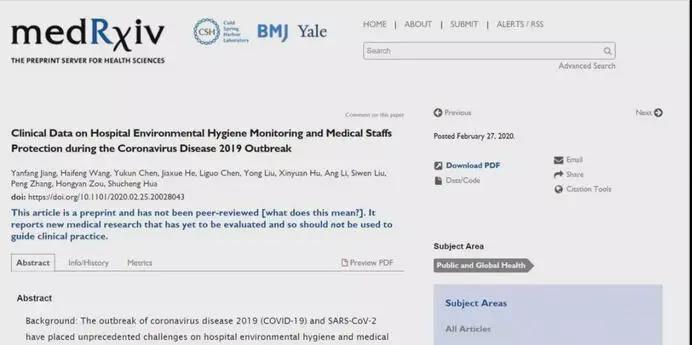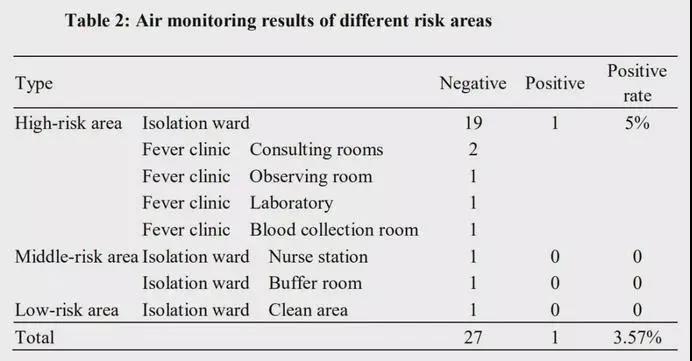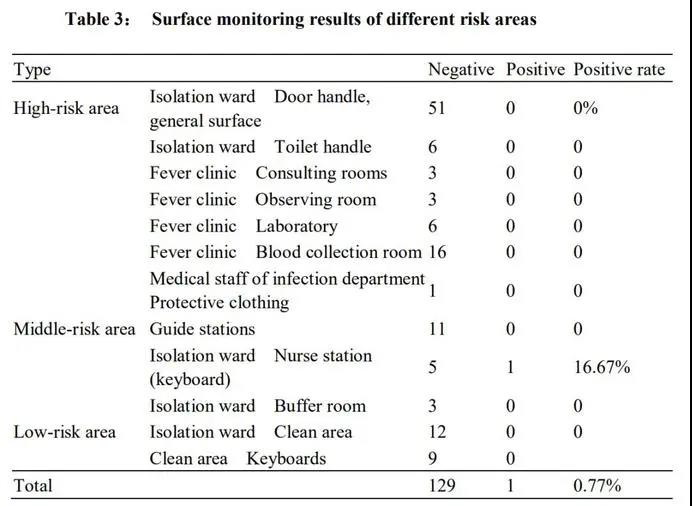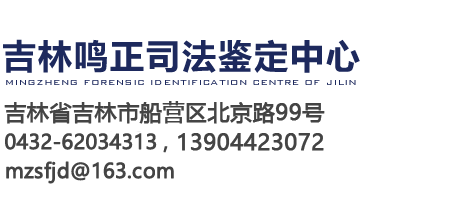根据《新型冠状病毒肺炎流行病学特征分析》报告,截至2月11日,共有3019名医务人员感染了新型冠状病毒(包括确诊病例、疑似病例、临床诊断病例及无症状感染者,其中确诊病例1716名)。
新冠肺炎来势汹汹,众多医护人员依然奋战在临床一线参与救治。然而,新冠病毒的高传播风险和感染率为医院防控和医护人员的防护提出了新的挑战。吉林大学第一医院华树成教授团队,采集了吉林大学第一医院隔离病房、发热门诊、导诊台等处空气、物表、门把手等样本,以及密切接触新冠患者的医护人员样本,使用RT-PCR法对样本中的新型冠状病毒核酸进行了检测。2月27日,该研究以Clinical Data on Hospital Environmental Hygiene Monitoring and Medical Staffs Protection during the Coronavirus Disease 2019 Outbreak为题,发表在医学预印本网站medRxiv上。检测结果显示,疑似患者隔离区的护士站的表面,以及重症监护病房的空气中,都检测到了新冠病毒。论文中提示,核酸检测可用于医院环境监测,并提示了医院环境中存在新冠病毒的可能原因及潜在风险,为流行性疾病疫情期间医院的感控和医护人员的防护提供了依据。研究人员从吉林大学第一医院的导诊台、发热门诊和隔离病房区域收集了158个空气和物体表面样本(空气样本28个,物体表面样本130个),这些样本很可能被确诊患者和疑似患者所污染。检测结果显示,重症监护室的空气中存在病毒,疑似患者隔离区的护士站的表面也检测到了病毒。空气样本的阳性率分别为3.57%(1/28),表面样品的阳性率为0.77%(1/130),总阳性率为1.26%(2/158)。这些发现表明,病毒既存在于物体表面又存在于空气中。这项研究结果表明,在疫情爆发期,对医院环境卫生的全面监控有利于完善医院的感染控制,通过检测医院环境卫生,对确保医疗安全和医院感染控制质量具有重要意义。
The isolation wards in general hospitals have all been transformed into temporary wards and cannot meet the standard of isolation wards in infectious disease hospitals.Such temporary isolation wards have many concerns and require further environmental monitoring assessments. The hermetic spaces of isolation ward is weak of air flow, may cause the high constract of virus. Our positive results of nuclear acid tests indicated that viruses are present in the air of an isolation ward with intensive care patients. Additionally, the confirmed patient underwent tracheal intubation the day before samples were collected, and this procedure produces large amounts of aerosols that spread in the wards and seriously pollutes the air. The traditional methods to sterilize the environment are performed with 75% alcohol, ultraviolet disinfection and chlorinated disinfectant, show a limit effect. These data indicated that conventional chlorine disinfection and 24-hour ultraviolet disinfection filtration cannot clear the virus from the air and hospital workers under the inadequate protection may carry a risk of infection in the isolation ward during care activities with intensive care patients. Therefore, it is necessary to increase the intensity of disinfection for isolation wards with intensive care patients. Siegel et al. reported that medical ventilators might generate respiratory aerosols that have been associated with an increased risk of occupationally acquired infection among healthcare personnel.Thus, an additonal and effective disinfection is very necessary for hospital infection control and medical staffs' protection. We should enhance ventilator exhaust management, for example, by adding ventilator exhaust port filters.The suspected and confirmed patients stay a relatively long time in the high risk area may influence the environment. The intrusive and other operations which are easily porduce aerosols may cause serious air pollution. The under observation sites without patient and operation have less impact on the environment. The samples from same collected point were test after taken a series of infection prevention and control measures, such as using of air disinfection machine for the ward air disinfection continuously, extending the frequency of disinfection for ground and object surfaces, changing the gloves and clean hands after operation and leaving the ward, covered computer keyboard and change the cover each day. The results are negative, showed the effectiveness of disinfection. The high-risk areas such hospital guide stations andfever clinic, due to the open enviorement and large air flow, the results were negative.At present, the cleaning work in most hospitals is provided by socialized services, which are ability to perform routine cleaning and disinfection.A more professional and targeted disinfection which is offered by infection control department and hospital system but not the by socialized services, is very necessary when the highly infectious diseases or pathogenic microorganisms appear. The routine cleaning and disinfection is most likely cause the deficiency of disinfection of the hospital environment, leading to the spread of pathogens. In our study, viruses were detected on the surfaces of nurse station in isolation area with suspected patients, suggested that we need to strengthen the surface disinfection of nurse stations, especially focusing on computer keyboards, mice and equipment that are not easy to disinfect.A large number of studies have shown that the hands or gloves of medical staffs may be contaminated bycontact with environmental surfaces contaminated by pathogens . In the process of diagnosis and treatment, pathogens may be transmitted to patients and causehospital-associated infections. Therefore, it is also very important to further strengthen the hand hygiene of medical staffs.There are still deficiencies in hospital environmental hygiene. We need to formulate refinement measures based on environmental hygiene monitoring data to improve the quality of hospital infection control. Due to the"uncultivable"microbe widely exist, traditional method to measure the effect of hospital infection control such as sedimentation (exposuring the plate in the enviorment) showed limit and insensive effect. For the labortary and testging organization,. high contraction of mucleas acidmay exists in aerosol, may infulence the test result and operater's safety, even cause the spreading. The nucleic acid detect provide an effective method to monitor the environment and evaluate the effectiveness of disinfection, especially for the highly contagious diseases or pathogenic microorganisms with a potential aerosol risk like COVID-19. These nucleic acid detect results are very important for the standardized hospital infection control. This study also increases the understanding of theenvironmental challenges corresponding to reemergence of 2019-nCoV or similar viruses.The data obtained in this study suggest that 2019-nCoV enters the air of the isolation ward with intensive care patients and deposits on the surfaces of nurse stations and that medical staffs encounter this virus in the air and on surfaces during patient care activities. The effective disinfection may reduce the risk of bio-safety.For hospital infection control, we suggest:1. Different people are responsible for the isolation observation area and the isolation ward area respectively, area crossing is strictly prohibited.2. Objects in each district should be used exclusively; for those cannot be used for special purposes should be sterilized before being used in other areas.3. Strickly observing hand hygiene rules thoroughly and in time.4. An additional gloves, disposable isolator, protective screen or hood should be weared when the opertaion may cause the spattering of blood, body fluid and aerosol, which should be discarding in time to avoid the pollution of other area.









